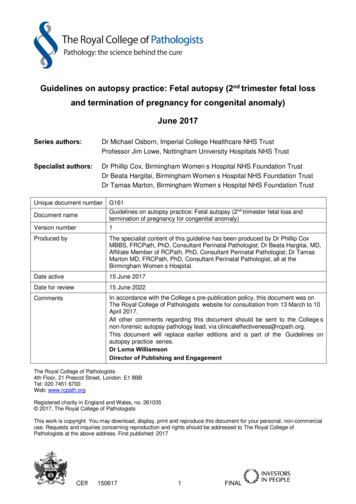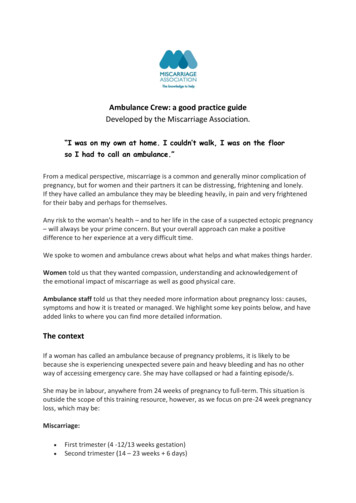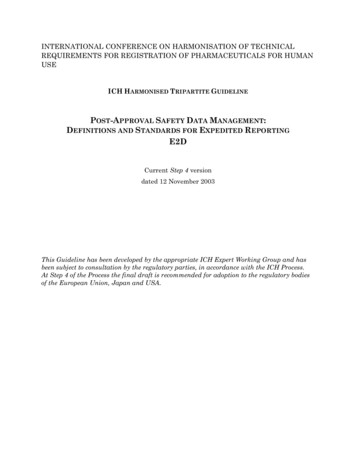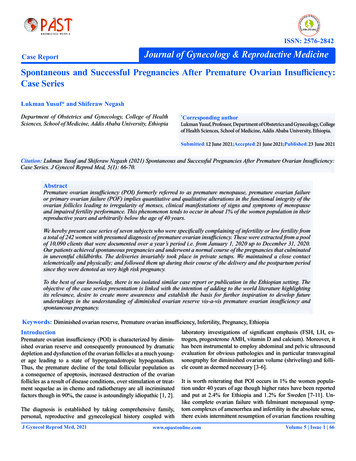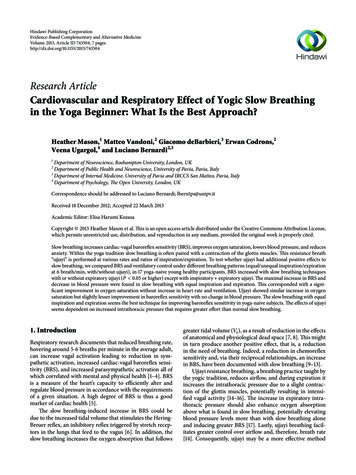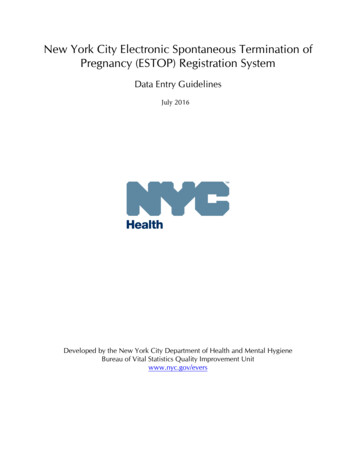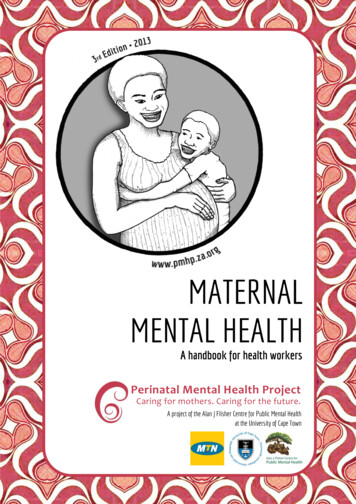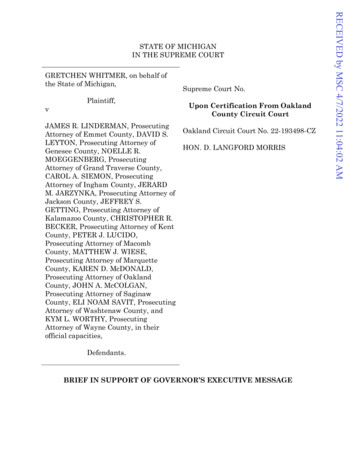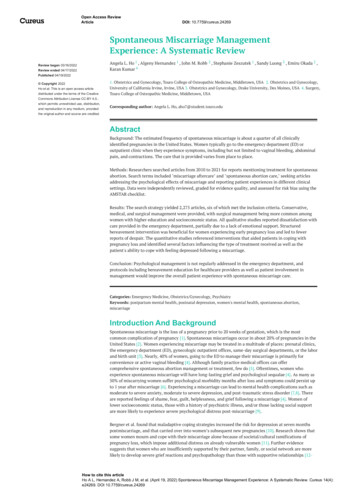
Transcription
Open Access ReviewArticleDOI: 10.7759/cureus.24269Spontaneous Miscarriage ManagementExperience: A Systematic ReviewAngela L. Ho 1 , Algeny Hernandez 1 , John M. Robb 2 , Stephanie Zeszutek 1 , Sandy Luong 3 , Emiru Okada 2 ,Karan Kumar 4Review began 03/16/2022Review ended 04/17/2022Published 04/19/2022 Copyright 2022Ho et al. This is an open access articledistributed under the terms of the Creative1. Obstetrics and Gynecology, Touro College of Osteopathic Medicine, Middletown, USA 2. Obstetrics and Gynecology,University of California Irvine, Irvine, USA 3. Obstetrics and Gynecology, Drake University, Des Moines, USA 4. Surgery,Touro College of Osteopathic Medicine, Middletown, USACommons Attribution License CC-BY 4.0.,which permits unrestricted use, distribution,and reproduction in any medium, providedCorresponding author: Angela L. Ho, aho7@student.touro.eduthe original author and source are credited.AbstractBackground: The estimated frequency of spontaneous miscarriage is about a quarter of all clinicallyidentified pregnancies in the United States. Women typically go to the emergency department (ED) oroutpatient clinic when they experience symptoms, including but not limited to vaginal bleeding, abdominalpain, and contractions. The care that is provided varies from place to place.Methods: Researchers searched articles from 2010 to 2021 for reports mentioning treatment for spontaneousabortion. Search terms included "miscarriage aftercare" and "spontaneous abortion care," seeking articlesaddressing the psychological effects of miscarriage and reporting patient experiences in different clinicalsettings. Data were independently reviewed, graded for evidence quality, and assessed for risk bias using theAMSTAR checklist.Results: The search strategy yielded 2,275 articles, six of which met the inclusion criteria. Conservative,medical, and surgical management were provided, with surgical management being more common amongwomen with higher education and socioeconomic status. All qualitative studies reported dissatisfaction withcare provided in the emergency department, partially due to a lack of emotional support. Structuredbereavement intervention was beneficial for women experiencing early pregnancy loss and led to fewerreports of despair. The quantitative studies referenced interventions that aided patients in coping withpregnancy loss and identified several factors influencing the type of treatment received as well as thepatient's ability to cope with feeling depressed following a miscarriage.Conclusion: Psychological management is not regularly addressed in the emergency department, andprotocols including bereavement education for healthcare providers as well as patient involvement inmanagement would improve the overall patient experience with spontaneous miscarriage care.Categories: Emergency Medicine, Obstetrics/Gynecology, PsychiatryKeywords: postpartum mental health, postnatal depression, women's mental health, spontaneous abortion,miscarriageIntroduction And BackgroundSpontaneous miscarriage is the loss of a pregnancy prior to 20 weeks of gestation, which is the mostcommon complication of pregnancy [1]. Spontaneous miscarriages occur in about 20% of pregnancies in theUnited States [2]. Women experiencing miscarriage may be treated in a multitude of places: prenatal clinics,the emergency department (ED), gynecologic outpatient offices, same-day surgical departments, or the laborand birth unit [3]. Nearly, 40% of women, going to the ED to manage their miscarriage is primarily forconvenience or active vaginal bleeding [4]. Although family practice medical offices can offercomprehensive spontaneous abortion management or treatment, few do [5]. Oftentimes, women whoexperience spontaneous miscarriage will have long-lasting grief and psychological sequalae [4]. As many as50% of miscarrying women suffer psychological morbidity months after loss and symptoms could persist upto 1 year after miscarriage [6]. Experiencing a miscarriage can lead to mental health complications such asmoderate to severe anxiety, moderate to severe depression, and post-traumatic stress disorder [7,8]. Thereare reported feelings of shame, fear, guilt, helplessness, and grief following a miscarriage [4]. Women oflower socioeconomic status, those with a history of psychiatric illness, and/or those lacking social supportare more likely to experience severe psychological distress post-miscarriage [9].Bergner et al. found that maladaptive coping strategies increased the risk for depression at seven monthspostmiscarriage, and that carried over into women’s subsequent new pregnancies [10]. Research shows thatsome women mourn and cope with their miscarriage alone because of societal/cultural ramifications ofpregnancy loss, which impose additional distress on already vulnerable women [11]. Further evidencesuggests that women who are insufficiently supported by their partner, family, or social network are morelikely to develop severe grief reactions and psychopathology than those with supportive relationships [12-How to cite this articleHo A L, Hernandez A, Robb J M, et al. (April 19, 2022) Spontaneous Miscarriage Management Experience: A Systematic Review. Cureus 14(4):e24269. DOI 10.7759/cureus.24269
14].Experiences during health care encounters can also add stressors to a traumatic experience. Patients whoexperienced a lack of emotional support expressed feelings of being alone and unheard while they were in aconfused and fearful state [4]. Psychological and supportive care following a miscarriage has not beenextensively studied and lacks single-blinded randomized controlled trials in this area of research [15].Interventional studies are also sparse.The purpose of this review is to identify, evaluate, and summarize the findings of all relevant individualstudies regarding spontaneous miscarriage psychological treatment and patient experiences in variousclinical settings in the USA.ReviewInclusion criteriaThis study was conducted as a systematic review utilizing PubMed and EBSCO databases. The search termswere "miscarriage care" and "spontaneous abortion care." These keywords were used to search for articlespublished after 2010 whose full text was available in English. The search was restricted to human researcharticles, including case reports, clinical trials, and comparative studies published in peer-reviewed journals.Only studies including female participants between the ages of 18 and 64 who experienced spontaneousmiscarriage were included. We included studies that specified miscarriage aftercare provided in an inpatient(emergency department) and outpatient setting (obstetric/gynecology clinic), studies highlighting differentmedical treatments for miscarriage, studies reporting patient experiences in different clinical settings, andstudies conducted in the US.Exclusion criteriaStudies that did not specify any clinical diagnosis of miscarriage, non-peer-reviewed literature, systematicreviews, opinion articles, and editorials were excluded.The search took place in September 2021. The selection of studies for this systematic review was presentedusing the Preferred Reporting Items for Systematic Reviews and Meta-analyses guidelines (Figure 1) [16].Data including samples, study design, clinical setting, primary results, and main findings were extractedfrom eligible studies (Table 1). The quality of our systematic review was assessed by the AMSTAR checklist[17].2022 Ho et al. Cureus 14(4): e24269. DOI 10.7759/cureus.242692 of 8
FIGURE 1: PRISMA flow chart of literature searchPRISMA: Preferred Reporting Items for Systematic Reviews and Meta-analysesAuthorPublication yearLocationStudy designSample sizeJohnson and Langford [18]2015EDProspective40Miller et al. [7]2019ED or ambulatory clinicsMixed methods54Punches et al. [19]2019EDQualitative8Schreiber et al. [20]2016EDMixed methods55Baird et al. [4]2018EDQualitative67Wilson et al. [21]2016Pregnancy loss centerProspective70TABLE 1: Characteristics of studies reporting spontaneous miscarriage treatment in U.S.Of the 2,275 articles identified, 904 were removed as duplicates, and 1371 were screened. Of these, 1217 wereexcluded based on title review, and an additional 15 were excluded during the subsequent abstract review.The remaining 139 reports were sought for retrieval, with one report unable to be acquired. Full-textassessment of the remaining 138 accessed articles yielded 132 that failed to meet eligibility criteria, withmany of the studies taking place outside of the US. Ultimately, six articles were selected. Of the six includedstudies, four contained quantitative analyses (Table 2), and four contained qualitative analyses (Table 3).Two of the six studies included in this review contained both qualitative and quantitative data.2022 Ho et al. Cureus 14(4): e24269. DOI 10.7759/cureus.242693 of 8
AuthorTreatmentJohnsonand ncydepartmentorMiller et al.[7]ambulatoryonly careMain outcomemeasuresPrimary resultsPerinatal griefscaleWomen who received bereavement intervention immediately after miscarriage were ableto better cope with pregnancy loss.Time tomiscarriagePatients seeking miscarriage care in the ED were likely lower socioeconomic class andresolution;number of healthpsychosocially vulnerable. The median time to miscarriage resolution was 11 days forwomen treated in the ED and 8 days who were treated in an ambulatory setting.care systeminteractions; andnumber of carePatients treated in the ED were more likely to be younger (28.3 vs. 34.0), of black race,uninsured or insured through Medicaid, and more likely to meet criteria for posttraumatic stress disorder vs. patients treated in ambulatory clinics.teamsSchreiber etal. 28-item briefWilson et al.Doula[21]supportcope score, 28itemempowermentscore, 10-itemassessment ofemotional stateSurgical management was more likely in women with higher education, higher monthlyincome and less likely to report depression. Multigravidas were more likely to stick withtheir initial treatment choice after counseling than primigravida.Doula support does not significantly affect physical discomfort during surgicalmanagement of spontaneous abortion. There are no statistically significant differencesin satisfaction, emotional response, sense of empowerment or ability to cope betweenwomen who received doula support and women who received routine care. Doulasupport during office uterine aspiration is desired during office uterine aspiration forearly pregnancy loss.TABLE 2: Summary of quantitative studies investigating spontaneous miscarriage treatmentsAuthorPuncheset al. [19]Baird etal. [4]Study GoalPrimary ResultsTo understand the perspectives of women whoundergo pregnancy loss treatment in the ED onprovision of careal. [7]lack of privacy and provider unawareness of miscarriage patient needs.Poor communication was described between providers and patients,especially delayed communication of diagnosis.To understand why women present to emergencydepartment for spontaneous abortion care, howMany participants reported chaos, lack of information or lack of emotionalsupport. Abnormal vaginal bleeding was the driving factor for seekingpatients perceive counseling taken place there,and overall experience during and after visitcare in the ED. Many women reported feeling unsure of next steps andwhat to expect following the ED visit.Schreiber To assess what drives satisfaction withet al. [20] spontaneous miscarriage careMiller etParticipants reported frustration with the environment of the ED, includingTo detail the experiences of patients presentingwith miscarriage in ED or ambulatory clinicsettingsParticipants were frustrated with the time of obtaining definitive diagnosis.Prior pregnancy experiences affected the patients’ miscarriagemanagement decision.Participants were more satisfied in ambulatory care settings, citingperceived efficiency of care and confidence in diagnosis. Patients in EDsettings were dissatisfied with the lengthy timing of diagnosiscommunication and inadequate compassion received from careproviders.TABLE 3: Summary of qualitative studies investigating spontaneous miscarriage treatmentsSpontaneous miscarriage treatment providedThe included studies evaluated various aspects of miscarriage treatment and management. Two specificallyassessed outcomes from medical, surgical, and expectant/conservative management. Medical treatmentincluded the use of prostaglandin analogs, such as misoprostol. Schreiber et al. and Wilson et al. utilizeddilation and curettage and/or dilation and evacuation [20,21].The selection of expectant, medical, or surgical treatment for spontaneous miscarriage was influenced by2022 Ho et al. Cureus 14(4): e24269. DOI 10.7759/cureus.242694 of 8
factors such as socioeconomic status, level of education, and prior pregnancies. Patients with a higher levelof education and income chose more invasive treatments over medical and expectant care for variousreasons, including the need to return to work [20]. Participants of lower socioeconomic status made up mostof the population treated in the ED [7,18,22]. Miller et al. found women who are socioeconomically andpsychosocially vulnerable are more likely to meet the criteria for post-traumatic stress syndrome (PTSD)three months after miscarriage [7]. Given that miscarriage is a traumatic experience, the development ofPTSD post-miscarriage is not surprising.Although spontaneous miscarriage is a common occurrence, there are few studies conducted in the US thatfocus on the psychological treatment for spontaneous miscarriage. The review identified two interventionsfor addressing the psychological effects of miscarriage, including doula assistance or bereavementintervention [18,21]. A doula is a trained layperson who provides continuous support to a womanthroughout her pregnancy, including praise, encouragement, comfort measures, explanations about thelabor progress, and other information pertaining to pregnancy and delivery [23]. Johnson’s study included aone-hour bereavement intervention based on Guidelines for Medical Professionals Providing Care to theFamily Experiencing Perinatal Loss, Neonatal Death, SIDS, or other Infant Death, which was provided for thetreatment group. The bereavement protocol included: (a) acknowledgment of pregnancy loss by labeling thepatient's room and chart; (b) chaplain services; (c) addressing special requests, including baptism or prayer;(d) a packet of flower seeds of remembrance; (e) a soft plush bear; (f) other physical momentos, ifapplicable; (g) naming ceremony participation; and (h) a self-addressed sympathy card [18]. A one-weekfollow-up telephone call upon discharge was also completed to reinforce information from the bereavementintervention and encourage women to seek continued emotional support [18].Nevertheless, since women are at risk for various psychopathologies postmiscarriage, a number of genericpsychological and psychiatric assessments (i.e., General Health Questionnaire, Hospital Anxiety andDepression scales, coupled with questions about symptoms of trauma, or Perinatal Grief Scale) could provideinsight into the psychological needs of these patients [24-26].Women’s experience with pregnancy lossCommon themes across the qualitative studies included frustration with the chaotic clinical environment,poor communication, and delays in delivery of diagnosis. Miller et al. and Punches et al. reported mixedexperiences in the ED, with some participants satisfied with the providers’ ability to tailor care by allowingtime to cope, while others were upset with the multiple staff handoffs, extensive wait times, and lack ofprivacy in their care [7,19]. Other studies reported unfriendly environments and a lack of emotional supportoffered by ED staff [4,27]. In the ED, care is often rushed and women are not given the option to see their lostchild, leading to emotional turmoil [28]. Sometimes women were told to subside their concerns and feltneglected by healthcare providers who demonstrated a lack of compassion in care [19,29-32]. Manyinterviewees were confused about the cause of their pregnancy loss and desired a better understanding ofthe diagnosis and how to prevent future occurrences [4]. Time constraints of ED providers needing to seemultiple patients quickly in order to maintain the "flow" of the department are likely a contributing factor inthe negative perception [33].In contrast, patients who received miscarriage treatment in an ambulatory clinic had a clearer and morestreamlined experience with their diagnosis and treatment options. [7]. Overall patient satisfaction withcare is associated with the presence of supportive staff and with the dissemination of sufficient informationregarding miscarriage [20].Benefits of psychological intervention and emotional supportIt can be a traumatizing experience to have to go to a healthcare facility to address a miscarriage.Miscarriage is known to have negative psychological effects on women, including clinical symptoms ofdepression and anxiety that may occur within the first-week post-miscarriage, and the emotional experiencecan persist even after the grief subsides [34,35]. Active grieving is expected following a spontaneousmiscarriage, and when coping strategies fail, feelings of despair typically set in [36]. The DSM-IV includesgrief within the description of major depressive episodes combined with weight loss, guilt, insomnia, andthoughts of self-harm/suicide [37]. A study identified a significantly higher annual suicide rate in womenwho had miscarried within one year prior to their suicide compared to women who had delivered a baby(18.1 out of 100,000 vs. 5.9 out of 100,000); however, this reaction to pregnancy loss is extreme [38].Research has shown that persistent depression is linked to childless women, which could be a targetintervention group for future studies [9].Johnson and Langford provided evidence that bereavement intervention can help women better cope withearly pregnancy loss [18]. Protective factors against post-miscarriage psychiatric illnesses includemultiparity, partner/social support, higher level of education and socioeconomic status, and no prior historyof mental illness [9,39]. Therefore, women who lack these protective factors will benefit more frombereavement intervention. Women who received the bereavement intervention reported 50% lower levels ofdespair in comparison to those who did not receive the intervention [18]. Thus, counseling interventionsshould be offered to all patients due to the prevalence of persistent depression linked with miscarriage [9]. If2022 Ho et al. Cureus 14(4): e24269. DOI 10.7759/cureus.242695 of 8
these services are provided shortly after the miscarriage, they may be effective in lowering grief, depression,and anxiety [40-45].Wilson et al. found that doula support during surgical management of spontaneous miscarriage had nosignificant effect on procedural pain score or pre/post-procedure anxiety [21]. Although doula support didnot substantially affect women’s emotional responses or ability to cope with pregnancy loss, over 50% ofwomen reported that doulas helped distract them from their negative emotions during the procedure [21].Many would want a doula in the future, would recommend doula support to a friend having a similarexperience, and thought doula services improved their overall experience [21]. Specialized attention fromproviders can be therapeutic for women experiencing pregnancy loss [46,47]. Thus, doula services have thepotential to address women’s unmet emotional needs before, during, and after surgical intervention [48].Health insurance coverage can be a barrier to obtaining doula services for some women [49,50]. However,doula services have been shown to lower the cost of care for institutions as these services can addressemotional and informational support gaps and aid in reducing complications during pregnancy by reducingpreterm births, morbidity, and cesarean deliveries [49,50].Recommendations to improve patient experienceSpontaneous abortion management experience is heavily affected by the efficiency of care, confidence in thequality of care, sensitive health care providers, and effective two-way communication. Emotional supportand patient inclusion in the decision-making process are crucial components of patient-centered care.Updates throughout the evaluation process can aid in avoiding misunderstandings and feelings of isolation,which were frequently reported [47]. As a result of a major gap in psychological care in miscarriagemanagement, support services have emerged as an adjunctive social movement [51,52]. Potentialinterventions to improve patient perception and insight into their own miscarriage care can be implementedby institutions to promote practices that will improve women’s experience when receiving care in the ED.Some ED providers feel unprepared to provide bereavement support; therefore, bereavement education canbe administered through structured computer-based education modules periodically throughout trainingand practice to better care for this population [53-55].The quality of miscarriage care is significantly better when providers give medical and emotional validationwhile keeping the patient involved in the clinical course and decision-making [20,56-59]. Patients should beeducated and given supplemental education materials routinely during pregnancy on the frequency ofmiscarriage, potential causes, potential preventative measures, and physical/psychological aftercare - all ofwhich can normalize and destigmatize this natural process [57]. Patients should be informed to first contacttheir primary care provider or OB/GYN if they develop concerning symptoms in order to assess if emergentinterventions are necessary. Information can be provided electronically or physically upon discharge fromthe ED, including support groups, bereavement services, chaplain services, or any other institutional orarea-specific resources. Some evidence supports the effectiveness of these resources for women whoexperienced neonatal death [60,61]. Communication between the ED and the patients’ primary care orobstetrics provider should be attempted in an effort to aid in continuity of care, subsequent follow-up visits,and telemedicine services.Limitations to the reviewOne limitation of this review is the geographical restriction to the US. Only studies published in peerreviewed journals were included to ensure reporting quality; thus, relevant gray literature was not evaluatedfor this study.ConclusionsDespite the limited number of studies available for this review, the studies that were available highlightimportant advances that can be made in miscarriage aftercare and where research is lacking. From what wehave reviewed, protocols are beneficial for this patient population in settings such as the ED, where medicaland psychological needs can be more effectively addressed. It is evident that psychological interventions arebeneficial for this patient population. Transparency and patient education regarding what will occur duringand after immediate care for spontaneous abortion are beneficial to the patient's mental and physical wellbeing as well as the overall patient experience.Additional InformationDisclosuresConflicts of interest: In compliance with the ICMJE uniform disclosure form, all authors declare thefollowing: Payment/services info: All authors have declared that no financial support was received fromany organization for the submitted work. Financial relationships: All authors have declared that they haveno financial relationships at present or within the previous three years with any organizations that mighthave an interest in the submitted work. Other relationships: All authors have declared that there are noother relationships or activities that could appear to have influenced the submitted work.2022 Ho et al. Cureus 14(4): e24269. DOI 10.7759/cureus.242696 of 8
Dugas C, Slane VH: Miscarriage. StatPearls [Internet], Treasure Island; 2022.Smart CJ, Smith BL: A transdisciplinary team approach to perinatal loss . MCN Am J Matern Child Nurs.2013, 38:110-4. 10.1097/NMC.0b013e318270db45Walter MA, Alvarado MS: Clinical aspects of miscarriage. MCN Am J Matern Child Nurs. 2018, 43:6-12.10.1097/NMC.0000000000000390Baird S, Gagnon MD, deFiebre G, Briglia E, Crowder R, Prine L: Women's experiences with early pregnancyloss in the emergency room: A qualitative study. Sex Reprod Healthc. 2018, 16:113-7.10.1016/j.srhc.2018.03.001deFiebre G, Srinivasulu S, Maldonado L, Romero D, Prine L, Rubin SE: Barriers and enablers to familyphysicians' provision of early pregnancy loss management in the United States. Womens Health Issues.2021, 31:57-64. 10.1016/j.whi.2020.07.003Lok IH, Neugebauer R: Psychological morbidity following miscarriage . Best Pract Res Clin Obstet Gynaecol.2007, 21:229-47. 10.1016/j.bpobgyn.2006.11.007Miller CA, Roe AH, McAllister A, Meisel ZF, Koelper N, Schreiber CA: Patient experiences with miscarriagemanagement in the emergency and ambulatory settings. Obstet Gynecol. 2019, 134:1285-92.10.1097/AOG.0000000000003571Quenby S, Gallos ID, Dhillon-Smith RK, et al.: Miscarriage matters: the epidemiological, physical,psychological, and economic costs of early pregnancy loss. Lancet (British edition). 2021, 1:397-1658.10.1016/S0140-6736(21)00682-6deMontigny F, Verdon C, Meunier S, Gervais C, Coté I: Protective and risk factors for women's mental healthafter a spontaneous abortion. Rev Lat Am Enfermagem. 2020, 28:e3350. 10.1590/1518-8345.3382.3350Bergner A, Beyer R, Klapp BF, Rauchfuss M: Pregnancy after early pregnancy loss: a prospective study ofanxiety, depressive symptomatology and coping. J Psychosom Obstet Gynaecol. 2008, 29:105-13.10.1080/01674820701687521Haws RA, Mashasi I, Mrisho M, Schellenberg JA, Darmstadt GL, Winch PJ: "These are not good things forother people to know": how rural Tanzanian women's experiences of pregnancy loss and early neonataldeath may impact survey data quality. Soc Sci Med. 2010, 71:1764-72. 10.1016/j.socscimed.2010.03.051Friedman T, Gath D: The psychiatric consequences of spontaneous abortion . Br J Psychiatry. 1989, 155:8103. 10.1192/bjp.155.6.810Forrest GC, Standish E, Baum JD: Support after perinatal death: a study of support and counselling afterperinatal bereavement. Br Med J (Clin Res Ed). 1982, 285:1475-9. 10.1136/bmj.285.6353.1475Cuisinier M, Kuijpers J, Hoogduin C: Miscarriage and stillbirth: time since the loss, grief intensity andsatisfaction with care. Eur J Obstet Gynecol Reprod Biol. 1993, 52:163-168. 10.1016/0028-2243(93)90066-lSan Lazaro Campillo I, Meaney S, McNamara K, O'Donoghue K: Psychological and support interventions toreduce levels of stress, anxiety or depression on women's subsequent pregnancy with a history ofmiscarriage: an empty systematic review. BMJ Open. 2017, 7:e017802. 10.1136/bmjopen-2017-017802Page MJ, McKenzie JE, Bossuyt PM, et al.: The PRISMA 2020 statement: an updated guideline for reportingsystematic reviews. BMJ. 2021, 372:n71. 10.1136/bmj.n71Shea BJ, Reeves BC, Wells G, et al.: AMSTAR 2: a critical appraisal tool for systematic reviews that includerandomised or non-randomised studies of healthcare interventions, or both. BMJ. 2017, 358:j4008.10.1136/bmj.j4008Johnson OP, Langford RW: A randomized trial of a bereavement intervention for pregnancy loss . J ObstetGynecol Neonatal Nurs. 2015, 44:492-9. 10.1111/1552-6909.12659Punches BE, Johnson KD, Acquavita SP, Felblinger DM, Gillespie GL: Patient perspectives of pregnancy lossin the emergency department. Int Emerg Nurs. 2019, 43:61-6. 10.1016/j.ienj.2018.10.002Schreiber CA, Chavez V, Whittaker PG, Ratcliffe SJ, Easley E, Barg FK: Treatment decisions at the time ofmiscarriage diagnosis. Obstet Gynecol. 2016, 128:1347-56. 10.1097/AOG.0000000000001753Wilson SF, Gurney EP, Sammel MD, Schreiber CA: Doulas for surgical management of miscarriage andabortion: a randomized controlled trial. Am J Obstet Gynecol. 2017, 216:44.e1-6. 10.1016/j.ajog.2016.08.039Tang N, Stein J, Hsia RY, Maselli JH, Gonzales R: Trends and characteristics of US emergency departmentvisits, 1997-2007. JAMA. 2010, 304:664-70. 10.1001/jama.2010.1112Klaus MH, Kennell JH: The doula: an essential ingredient of childbirth rediscovered . Acta Paediatr. 1997,86:1034-6. 10.1111/j.1651-2227.1997.tb14800.xGoldberg D: General Health Questionnaire (GHQ-12). NFER-Nelson, Windsor, UK; 1992.Zigmond AS, Snaith RP: The hospital anxiety and depression scale . Acta Psychiatr Scand. 1983, er Li, Lasker JN, Janssen HJ: International comparison of studies using the Perinatal Grief Scale: adecade of research on pregnancy loss. Death Stud. 2001, 25:205-238. 10.1080/07481180125971MacWilliams K, Hughes J, Aston M, Field S, Moffatt FW: Understanding the experience of miscarriage in theemergency department. J Emerg Nurs. 2016, 42:504-12. 10.1016/j.jen.2016.05.011Koziol-McLain J, Whitehill CS, Stephens L, O'Flaherty E, Morell M, Chapman M: An investigation ofemergency department patients' perceptions of their miscarriage experience. J Emerg Nurs. 1992, 18:501-4.10.5555/URI:PII:0099176792903135Covington D, Rickabaugh B: Caring for the patient with a spontaneous abortion . J Emerg Nurs. 2006, 32:5135. 10.1016/j.jen.2006.07.011Dougherty NA: Better ways to treat women with miscarriages: using a patient complaint to improveemergency department care. J Emerg Nurs. 1994, 20:521-7.Hutti MH: Miscarriage: the parent's point of view. J Emerg Nurs. 1988, 14:367-8.10.5555/URI:PII:0099176788902991Säflund K, Sjögren B, Wredling R: The role of caregivers after a stillbirth: views and experiences of parents .Birth. 2004, 31:132-7. 10.1111/j.0730-7659.2004.00291.xZ
Obstetrics and Gynecology, Touro College of Osteopathic Medicine, Middletown, USA 2. Obstetrics and Gynecology, . including the need to return to work [20]. Participants of lower socioeconomic status made up most . partner/social support, higher level of education and socioeconomic status, and no prior history of mental illness [9,39 .
